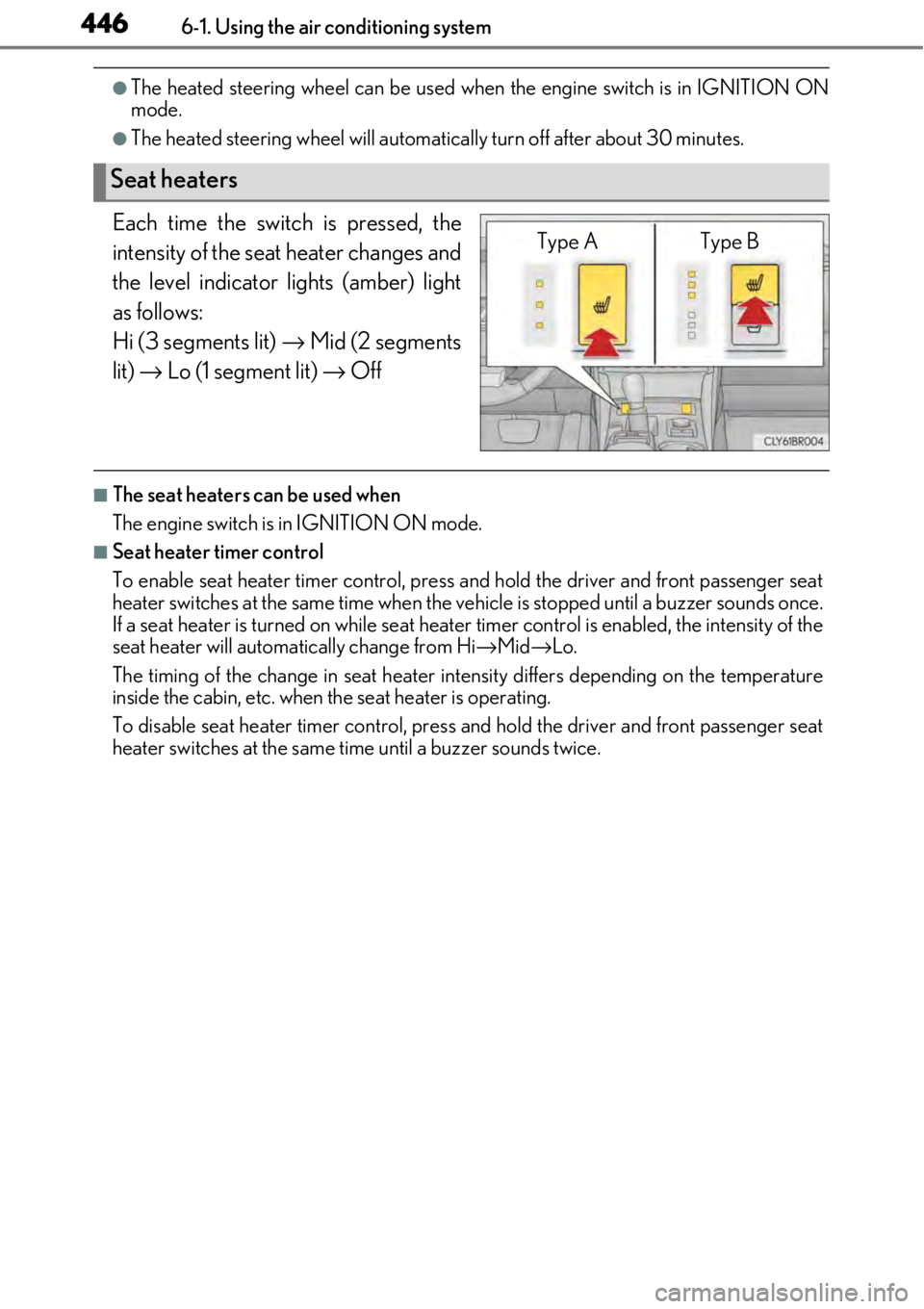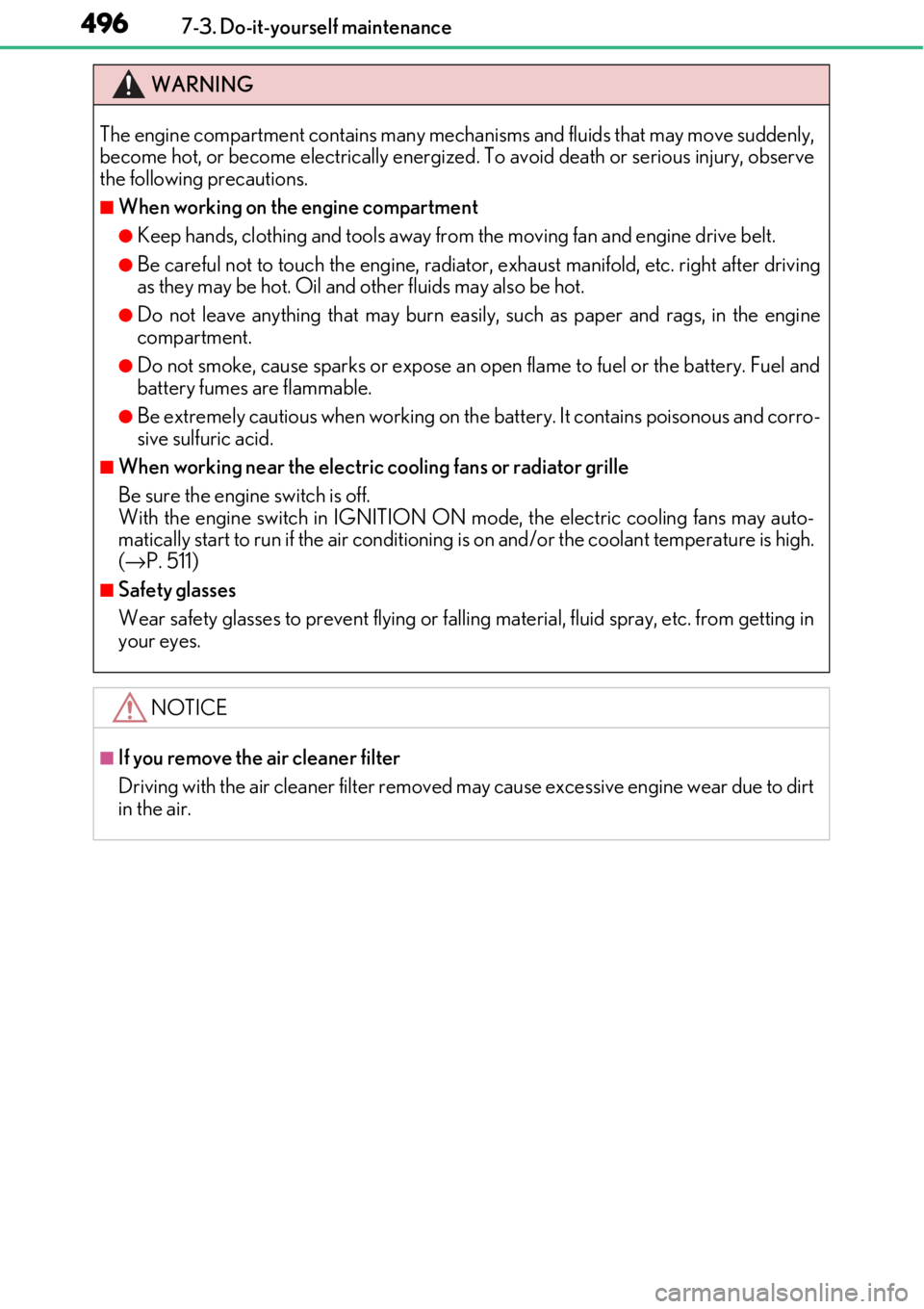Page 446 of 724

4466-1. Using the air conditioning system
●The heated steering wheel can be used when the engine switch is in IGNITION ON
mode.
●The heated steering wheel will automatically turn off after about 30 minutes.
Each time the switch is pressed, the
intensity of the seat heater changes and
the level indicator lights (amber) light
as follows:
Hi (3 segments lit) → Mid (2 segments
lit) → Lo (1 segment lit) → Off
■The seat heaters can be used when
The engine switch is in IGNITION ON mode.
■Seat heater timer control
To enable seat heater timer control, press and hold the driver and front passenger seat
heater switches at the same time when the vehicle is stopped until a buzzer sounds once.
If a seat heater is turned on while seat heater timer control is enabled, the intensity of the
seat heater will automa tically change from Hi→Mid →Lo.
The timing of the change in seat heater in tensity differs depending on the temperature
inside the cabin, etc. when the seat heater is operating.
To disable seat heater timer control, press and hold the driver and front passenger seat
heater switches at the same time until a buzzer sounds twice.
Seat heaters
Type A Type B
Page 447 of 724
4476-1. Using the air conditioning system
6
Interior features
Each time the switch is pressed, the
intensity of the seat ventilator changes
and the level indicator lights (green)
light as follows:
Hi (3 segments lit) → Mid (2 segments
lit) → Lo (1 segment lit) → Off
■The seat ventilators can be used when
The engine switch is in IGNITION ON mode.
Seat ventilators
Page 479 of 724

479
Maintenance and care7
7-1. Maintenance and careCleaning and protecting the vehicle exterior ............... 480
Cleaning and protecting the vehicle interior..................485
7-2. Maintenance Maintenance requirements ........................... 488
General maintenance............... 491
Emission inspection and maintenance (I/M)
programs .................................... 494
7-3. Do-it-yourself maintenance Do-it-yourself service precautions................................ 495
Hood ............................................... 497
Positioning a floor jack ............498
Engine compartment ................ 501
Tires ...................................................517
Tire inflation pressure................ 531
Wheels ........................................... 534
Air conditioning filter ............... 536
Electronic key battery ..............538
Checking and replacing fuses ..............................................540
Light bulbs..................................... 543
Page 496 of 724

4967-3. Do-it-yourself maintenance
WARNING
The engine compartment contains many mechanisms and fluids that may move suddenly,
become hot, or become electrically energize d. To avoid death or serious injury, observe
the following precautions.
■When working on the engine compartment
●Keep hands, clothing and tools away from the moving fan and engine drive belt.
●Be careful not to touch the engine, radiator, exhaust manifold, etc. right after driving
as they may be hot. Oil and other fluids may also be hot.
●Do not leave anything that may burn easily, such as paper and rags, in the engine
compartment.
●Do not smoke, cause sparks or expose an open flame to fuel or the battery. Fuel and
battery fumes are flammable.
●Be extremely cautious when working on the battery. It contains poisonous and corro-
sive sulfuric acid.
■When working near the electric cooling fans or radiator grille
Be sure the engine switch is off.
With the engine switch in IGNITION ON mode, the electric cooling fans may auto-
matically start to run if the air conditioning is on and/or the coolant temperature is high.
( → P. 511)
■Safety glasses
Wear safety glasses to prevent flying or falling material, fluid spray, etc. from getting in
your eyes.
NOTICE
■If you remove the air cleaner filter
Driving with the air cleaner f ilter removed may cause excessive engine wear due to dirt
in the air.
Page 536 of 724
5367-3. Do-it-yourself maintenance
Turn the engine switch off.
Open the glove box. Lift up the side
with the stay, disconnect the stay
tabs and remove the partition by
pulling horizontally.
Press the tabs and remove the filter
cover.
Press the tabs and remove the filter
case.
Air conditioning filter
The air conditioning filter must be changed regularly to maintain air condi-
tioning efficiency.
Removal method
1
2
3
4
Page 537 of 724
5377-3. Do-it-yourself maintenance
7
Maintenance and care
Remove the air conditioning filter
from the filter case and replace it
with a new one.
The “\bUP” marks shown on the filter
and the filter case sh ould be pointing up.
■Checking interval
Inspect and replace the air cond itioning filter according to the maintenance schedule. In
dusty areas or areas with heavy traffic fl ow, early replacement may be required. (For
scheduled maintenance informat ion, please refer to the “Owner’s Manual Supplement”
or “Scheduled Maintenance”.)
■If air flow from the vents decreases dramatically
The filter may be clogged. Check the filter and replace if necessary.
5
NOTICE
■When using the air conditioning system
Make sure that a filter is always installed.
Using the air conditioning system without a filter may cause damage to the system.
Page 563 of 724
5638-2. Steps to take in an emergency
8
When trouble arises
●Fluid leaks under the vehicle.
(Water dripping from the air conditioning after use is normal.)
●Flat-looking tires or uneven tire wear
●Engine coolant temperature gauge continually points higher than normal.
●Changes in exhaust sound
●Excessive tire squeal when cornering
●Strange noises related to the suspension system
●Pinging or other noises related to the engine
●Engine missing, stumbling or running roughly
●Appreciable loss of power
●Vehicle pulls heavily to one side when braking
●Vehicle pulls heavily to one side when driving on a level road
●Loss of brake effectiveness, spongy feeling, pedal almost touches the floor
If you think something is wrong
If you notice any of the following symptoms, your vehicle probably needs
adjustment or repair. Contact your Lexus dealer as soon as possible.
Visible symptoms
Audible symptoms
Operational symptoms
Page 586 of 724

5868-2. Steps to take in an emergency
*: Refer to the separate “Scheduled Maintenance” or “Owner’s Manual Supplement”
for the maintenance interval applicable to your vehicle.
■Warning messages
The warning message illustrations used are intended as examples, and may differ from
the image that is actually displaye d on the multi-information display.
■Warning message in radar cruise mode (if equipped)
In the following situations, the warning message may not be displayed even if vehicle-to-
vehicle distance decreases:
●When your vehicle and the vehicle ahead are traveling at the same speed or the vehicle
ahead is traveling more quickly than your vehicle
●When the vehicle ahead is traveling at a very low speed
●Immediately after cruise control speed is set
●At the instant the accelerator pedal is depressed
■The LDA (Lane Departure Alert) lane departure warning function
In the following situations, th e warning message will not be displayed even if a lane line is
crossed.
●When the vehicle speed deviates from the operating range of the LDA system func-
tions
●When the lane lines cannot be recognized
■Resetting the message indicati ng maintenance is required
Make sure to reset the oil change system. ( →P. 489)
■Conditions that the tire pressure wa rning system may not function properly
→ P. 522
■Warning buzzer
→P. 568
Indicates that operation of large electricity consuming
systems such as the air conditioning system are sus-
pended
→ Stop using unnecessary electric components to
reduce electricity consumpt ion. Wait a while until
the electric power supply is restored.
Warning messageDetails/Actions